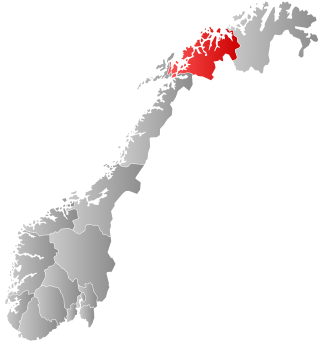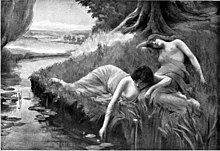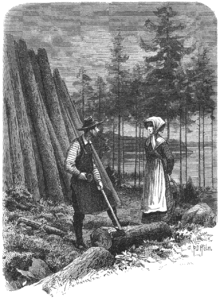
A troll is a being in Nordic folklore, including Norse mythology. In Old Norse sources, beings described as trolls dwell in isolated areas of rocks, mountains, or caves, live together in small family units, and are rarely helpful to human beings.
In Scandinavian folklore, the mylingar were the phantasmal incarnations of the souls of children that had been forced to roam the earth until they could persuade someone to bury them properly.

Troms is a county in northern Norway. On 1 January 2020 it was merged with the neighboring Finnmark county to create the new Troms og Finnmark county. This merger was reversed by the government resulting from the 2021 Norwegian parliamentary election on 1 January 2024.

Bardu is a municipality in Troms county, Norway. The administrative centre of the municipality is the village of Setermoen, the largest urban area in the municipality.

Storfjord is a municipality in Troms county, Norway. The administrative centre of the municipality is the village of Hatteng. Other villages in Storfjord include Elvevoll, Oteren, and Skibotn.

La Llorona is a vengeful ghost in Latin American folklore who is said to roam near bodies of water mourning her children whom she drowned in a jealous rage after discovering her husband was cheating on her.
A joik or yoik is a traditional form of song in Sámi music performed by the Sámi people of Sapmi in Northern Europe. A performer of joik is called a joikaaja, a joiker or jojkare. Originally, joik referred to only one of several Sami singing styles, but in English the word is often used to refer to all types of traditional Sami singing. As an art form, each joik is meant to reflect or evoke a person, animal, or place.

The Nixie, Nixy, Nix, Näcken, Nicor, Nøkk, or Nøkken are humanoid, and often shapeshifting water spirits in Germanic mythology and folklore.
Nordic folklore is the folklore of Denmark, Norway, Sweden, Iceland and the Faroe Islands. It has common roots with, and has been mutually influenced by, folklore in England, Germany, the Low Countries, the Baltic countries, Finland and Sápmi. Folklore is a concept encompassing expressive traditions of a particular culture or group. The peoples of Scandinavia are heterogenous, as are the oral genres and material culture that has been common in their lands. However, there are some commonalities across Scandinavian folkloric traditions, among them a common ground in elements from Norse mythology as well as Christian conceptions of the world.

Traditional Sámi spiritual practices and beliefs are based on a type of animism, polytheism, and what anthropologists may consider shamanism. The religious traditions can vary considerably from region to region within Sápmi.

The vættir are spirits in Norse mythology. The term can be used to refer to the full cosmos of supernatural beings, including the álfar (elves), dvergar (dwarves), jötnar (giants), and gods. Vættir can also refer more specifically to landvættir, fjallvættir, sjóvættir, skogvættir, vatnavættir, or húsvættir.

Tromsdalstinden (Norwegian) or Sálašoaivi / Sálaščohkka (Northern Sami) is a mountain in Tromsø Municipality in Troms og Finnmark county, Norway. The 1,238-metre (4,062 ft) tall mountain is located at the southern end of the Tromsdalen valley, just southeast of Tromsø. Snowfall varies from yearly, but the peak is usually snow free only for a few months in the summer. The mountain is easily spotted from the city centre of Tromsø. The summit is a popular hike, requiring nothing more than good shoes, average physical condition, and plenty to drink.

The church grim is a guardian spirit in English and Nordic folklore that oversees the welfare of a particular Christian church, and protects the churchyard from those who would profane and commit sacrilege against it. It often appears as a black dog but is known to take the form of other animals. In modern times, when black dogs are kept as pets in churches and their attached parsonages, these are called church Grims since they reside on and guard ecclesiastical property.
La Sayona is a legend from Venezuela, represented by the vengeful spirit of a woman that shows up only to men that have love affairs out of their marriages. The name "Sayona" refers to the cloth the ghost wears which is a long white dress similar to a medieval undergarment.
In Scandinavian folklore, a rå(in Swedish), is a spirit who is the keeper or warden of a particular location or landform. The rå is known both in Nordic culture and in the Sami culture, where it is called radie.

Jiehkkevárri is a mountain on the border of the municipalities of Lyngen and Tromsø in Troms og Finnmark county, Norway. It is the highest mountain in Troms og Finnmark and has the second highest prominence among Norwegian mountains. The 1,834-metre (6,017 ft) tall mountain sits about 10 kilometres (6.2 mi) northeast of the village of Lakselvbukt and about 17 kilometres (11 mi) southwest of the village of Lyngseidet.
Kivlemøyane is the popular name of three dairy maids in Seljord, Telemark, who according to legend were turned to stone. Their image is presented in a natural formation in the mountain of Skorve in the valley Kivledalen. The legend also formed the basis for a number of Norwegian folk tunes.
The Nachtkrapp is a South German and Austrian bugbear creature, cautionary tales about which are used to scare children into going to bed. Similar legends exist in Hungary, the Czech Republic, Poland, and Russia.
A vittra is a type of vættr from northern Sweden. A vættr is a nature spirit, a type of mythological creature very common in Scandinavian mythology. Experts are not certain if vittra, hulder, and näcken can be grouped together or not because all three of them support nature against humans and dangers.

The Skogsrå, Skogsfrun, Skogssnuvan, Skogsnymfen, Råndan or Huldran, is a mythical female creature of the forest in Swedish folklore.














